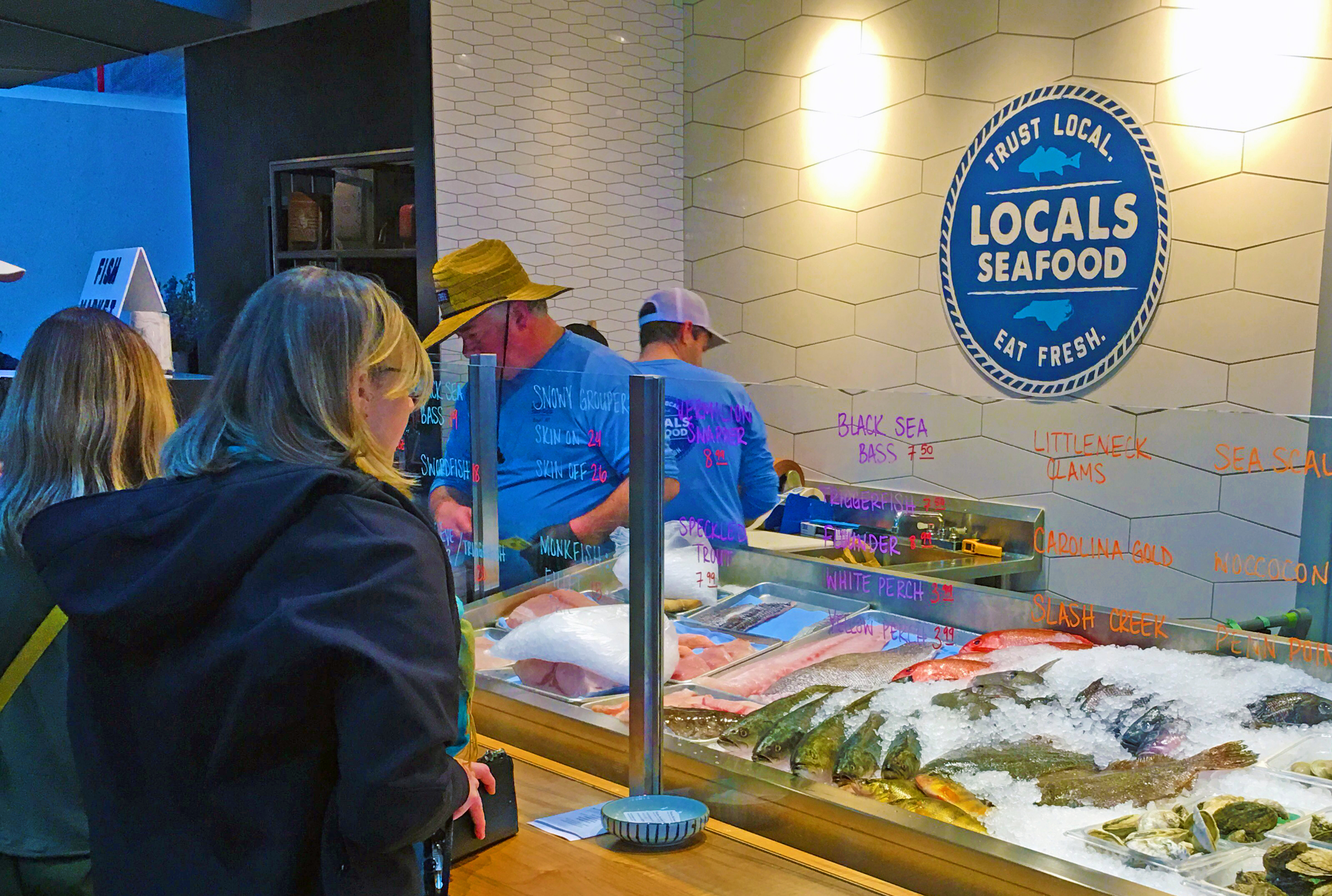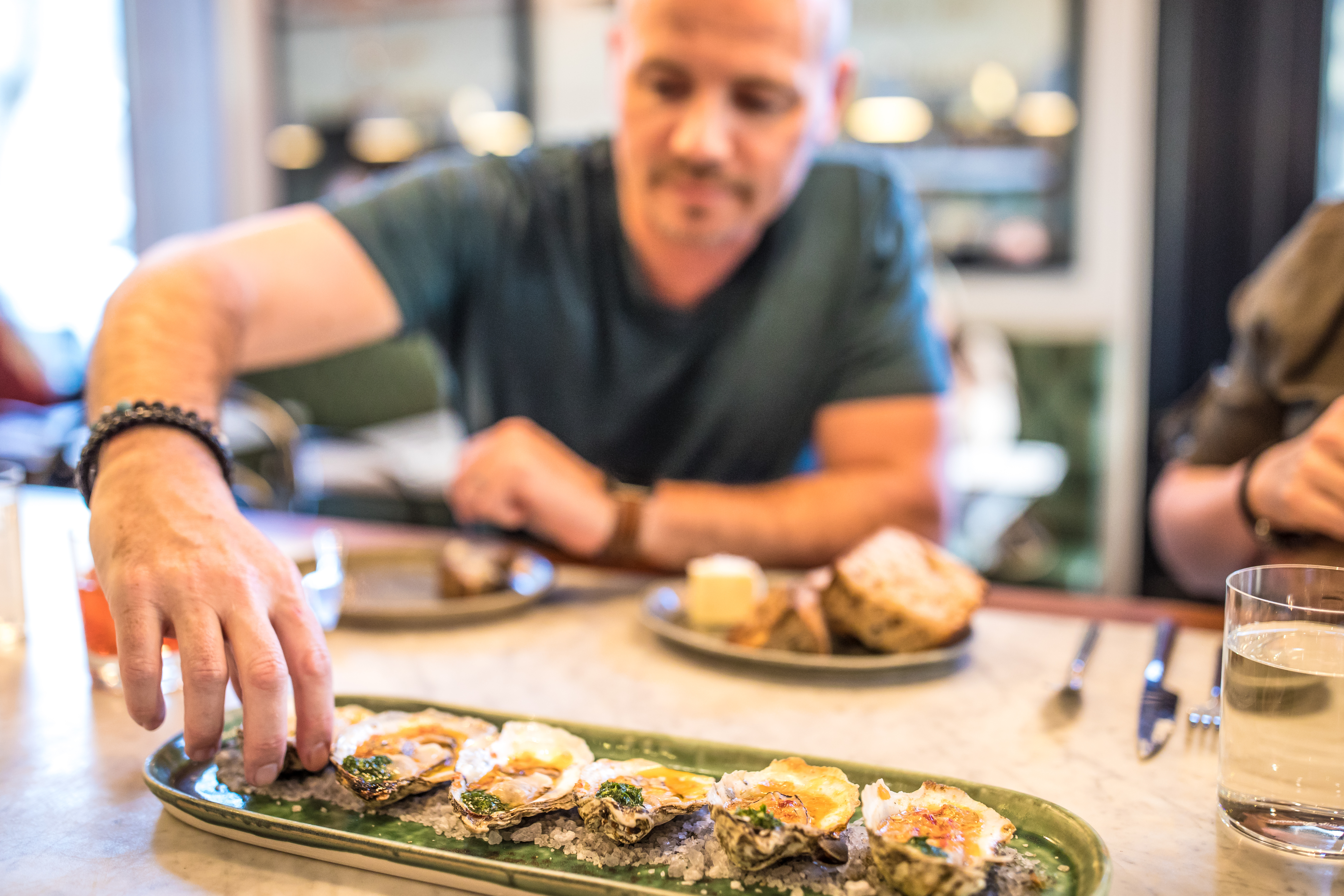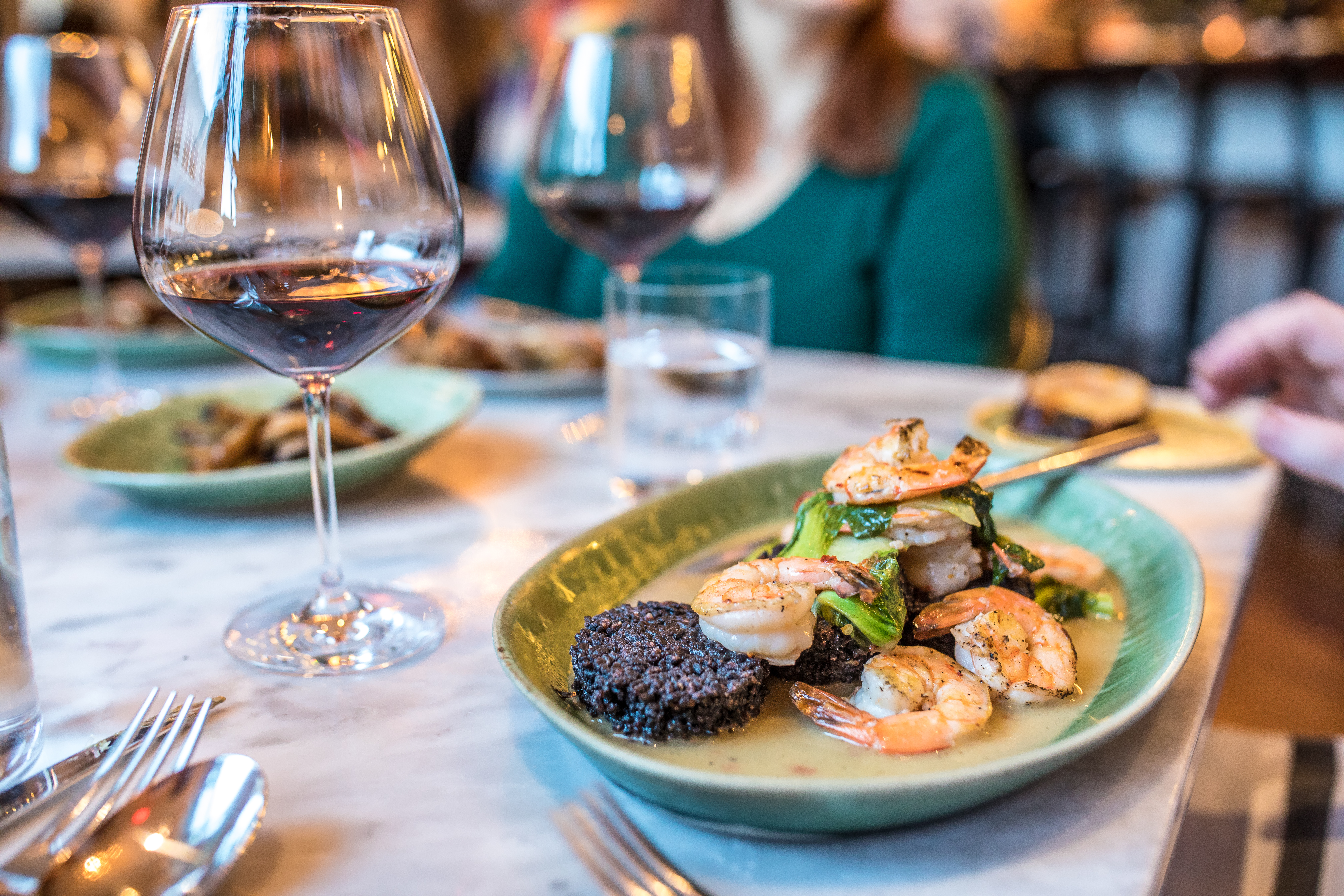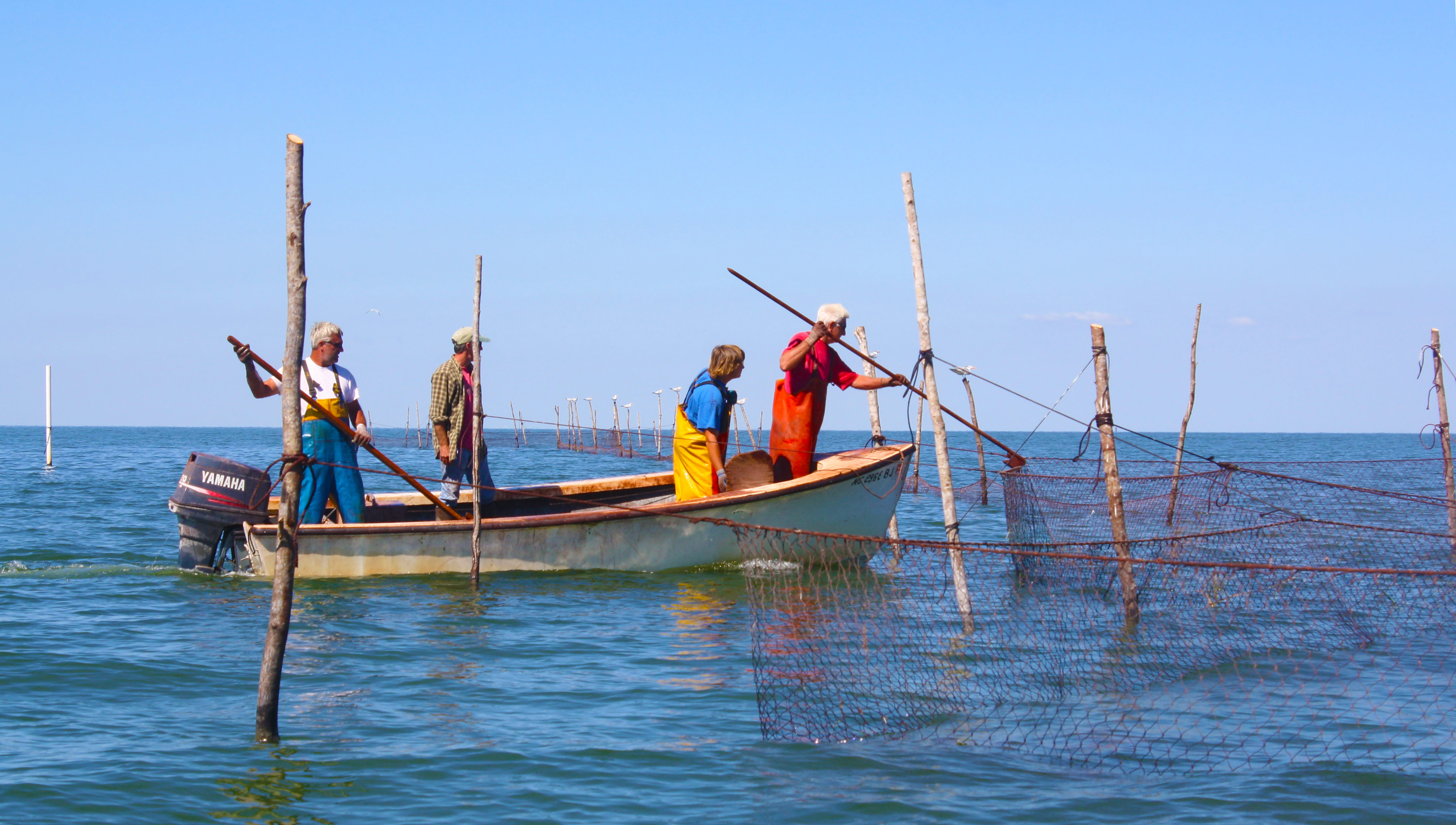A Fish for All Occasions: A Quest for the Heart of the Local Seafood Lover
Many North Carolina seafood lovers still enjoy cooking their favorite dishes in their own kitchens — but where is the North Carolina seafood market headed? The answer is complicated.

Soccer moms with grocery bags brimming with Hamburger Helper and Ramen noodles. Millennials who scoop ready-to-eat meals and gulp them down on the move. Fitness fanatics intent on fueling the Body Temple with healthy, pure, protein-rich diets. Aficionados of high cuisine, lovers of the dining experience, and the chefs who prepare their meals with flair. Husbands, wives, retirees in aprons — a pinch of spice always between thumb and forefinger — whose cooking remains a lifelong labor of love.
Is it possible for local seafood to satisfy these and the many other sorts of guzzlers, diners and devourers that shape the contemporary American food scene?
“Consumer research has shown that with today’s busy lifestyles people are searching for freshly prepared food options that are convenient to prepare and eat anywhere, especially at home,” says Barry Nash, North Carolina Sea Grant’s seafood marketing specialist. “But does this really apply to the local seafood market — and, if so, what does it mean for our state’s seafood producers and retailers?”
To find out, Nash went to the self- proclaimed fastest distributor of local seafood in the Raleigh-Durham-Chapel Hill area. Locals Seafood Company only sources its fish from points within a three-hour drive of the Triangle.
While apt for its simplicity, the Locals name alone doesn’t evoke an unmistakable element of efficiency — until, that is, you do business with them. The company has developed such a smooth-running supply chain from coastal North Carolina that Triangle restaurateurs can have fish on your plate within 24 hours of that same fish swimming in the Atlantic.
“That’s about a third of the turnaround time of our quickest competitors,” says Locals co-founder Ryan Speckman. “Freshness and quality are the main reasons local chefs rely on us for seafood.”
Nash says North Carolina’s seafood comes with built-in consumer appeal.
“There’s an obvious functional aspect to eating local seafood,” he says. “Consumers equate quick turnaround, from sea to table, with freshness. Plus, North Carolinians can support local producers — and get the highest quality cuts.”

Locals Seafood is booming. Less than a decade ago, Speckman and college buddy Lin Peterson started the enterprise by selling Stumpy Point shrimp out of a tailgate cooler on the side of the highway. Today, not only is Locals supplying more than four dozen chefs across the Triangle, Speckman and Peterson’s company additionally stocks a dozen grocers and regularly provides foodies with homegrown choices at farmer’s markets.
They also serve their own retail customers at Locals Oyster Bar and Seafood Market, an airy, hip, even trendy space in the Transfer Company Food Hall in downtown Raleigh. There, a massive floor fan rumbles on summer days, evoking a dockside restaurant, while customers devour authentic offerings from chef Eric Montagne, whose father taught him to fish in the south Florida seaways.
In search of the highest quality product, Locals’ seafood lovers can experience the difference between Woccocon and Slash Creek oysters, for instance, as well as enjoy much more from a wide sampling of both well-known and underappreciated fish. In many ways, the company is helping to maintain the state’s seafood as a vibrant niche market.
Nash says the North Carolina seafood market is brimming with potential, yet certain to face ongoing challenges.
“There’s a growing, global demand for seafood,” Nash explains. “But there’s also a finite supply of local products, an aging population of the fishing fleet, and quotas designed to keep fisheries sustainable, limiting catch sizes. It’s never been more important to identify exactly what consumers want.”
What do these challenges mean for Locals Seafood?
“We may need to change things,” Speckman says. “If we want to maintain our mission, we have to know how we can we squeeze every penny out of the local seafood market.”
To do that, diagnosing available market opportunities is critical — which is how Speckman, Peterson and Nash came to join forces on a quest for the heart of the North Carolina seafood consumer.

The Business Owner’s First Commandment
Speckman and Peterson have avoided the pitfalls of a classic cautionary tale — a story that starts with a young entrepreneur setting in motion what seems like an exceptional business plan. The company operates on an efficient model. The projected profit margins are solid. The owner invests liberally in clever advertising and publicity, and the PR generates an explosion of awareness. Thousands of people, in fact, learn about the company, its slogan and its products. And then it promptly goes out of business.
The problem, Nash says, is that many businesses don’t actually identify their core customers in order to learn what those consumers actually want, or how to meet their expectations and desires.
“The money and time it takes to actually understand your consumer base — their tastes and demands — is considerable,” he explains. “Most producers and retailers don’t have the resources to do this.”
Which means many new businesses end up suffering the wrath of the market.
Even Speckman — who has taught himself how to navigate numerous hoops and hurdles while shepherding Locals from that single roadside cooler to a successful business — says the company has tried a clunker of an idea or two.
“Home delivery,” he says, in a tone that doesn’t need an eye roll. “We ended up spending a lot of time getting from point A to point B. There was always some guy who only wanted a half-pound of shrimp delivered, and he was always the farthest away.”
Nash says that determining how best to meet customers’ needs and expectations is crucial, but it’s only one aspect of market research.
“In order to stay relevant, businesses must know how — and why — consumer desires change.”
According to Nash, consumer research already has outlined the broader story of the contemporary American food scene. Because we lead such busy lives, we’re apt to devour pre-prepared, impulse-driven products of convenience. We prefer fresh, transportable meals, with minimally-processed ingredients and without artificial preservatives. Bold flavors and “handcrafted” quality characterize the most successful new product launches of the last few years.
In addition, people increasingly want fresh, natural foods with greater nutritional value, which, many consumers believe, will help prevent or alleviate even serious health conditions. Over time, consumers have become more trusting of niche food brands from local and regional businesses, as opposed to impersonal and distant national chains or international conglomerates.
In fact, when choosing their foods, people today tend to swoon over fresh, locally sourced, high-protein ingredients. Protein-rich, low-fat marine animals — laden with heartbeat- regulating, blood pressure-lowering omega-3 fatty acids — seem a perfect place for health-conscious foodies to invest their trust.
But these trends and preferences don’t fully explain the complexities of the North Carolina seafood consumer base.
“North Carolina Sea Grant can help fill in the gaps in market research,” Nash says. “Right now, for instance, roughly three-quarters of seafood is consumed in restaurants. But what does that really mean for seafood producers and retailers in our state? Ryan, Lin and I wanted to learn what, exactly, North Carolina seafood consumers want to eat — and how they want to prepare it.”
Nash and Locals collaborated to design focus groups and online surveys that would elicit a fuller portrait of the seafood company’s consumer base and the North Carolina seafood market at large. Their specific questions asked why people shopped at Locals, why they ate seafood, which seafoods were favorites, and which typically lesser known species they were familiar with.
Their questions also went deeper, seeking to uncover how seafood fit within consumer expectations and understandings of cooking itself. They probed consumer interests in meal kits — prepared meal components that seafood lovers could assemble and cook at home. Additionally, they asked if consumers would make use of ready- to-eat or heat-and-serve seafood, for which occasions they would consider using either, if they preferred refrigerated or frozen seafood meals, and even if they preferred particular kinds of packaging.
Nash and Speckman teamed for a Raleigh focus group, and Ann Simpson, then executive director of North Carolina Catch, led another in Chapel Hill. The online survey drew responses from 318 customers, nearly all residing in the Triangle.
With this information in hand, they could begin to create a profile of North Carolina seafood lovers.

To Cook or Not to Cook
“First, we learned a lot about what was working,” says Speckman. “The research confirmed we have loyal and trusting customers.”
Nash says the company’s relationship with its customers, in fact, would be the envy of any business.
“It was abundantly clear from the focus groups,” says Nash. “People really trust Locals Seafood Company. Customers see the staff as knowledgeable and reliable when helping them make their selections.”
That trust goes a long way, especially given Locals’ dedication to freshness and quality, which means bringing any available and appetizing species — even if lesser known — to market when timeliness dictates. This approach, however, can require some adventurousness on the part of the consumer.
Most focus group participants were equal to the challenge, collectively reporting they were familiar with a wide array of species: amberjack, black drum, bluefish, cape shark, croaker, king mackerel, mullet, pink snapper, sheepshead, white grunt, and white perch.
But, far more importantly, they said they were willing to try anything if Locals Seafood was offering it.
The online survey revealed other key information, too, including consumers’ top three seafood favorites: oysters, clams and pink snapper. Participants also mentioned many other species they enjoyed from the North Carolina coast, including bass, crab, cobia, flounder, grouper, hogfish, mahi mahi, monk fish, octopus, pompano, scallops, shrimp, squid, Spanish mackerel, spots, swordfish, tilefish, triggerfish and tuna.
Lovers of North Carolina seafood, then, present a diverse and educated palate, for which Locals certainly deserves its share of the credit. Of course, credit also goes to the state’s long heritage of seafood cooking and consumption.
But where is the North Carolina seafood market headed?
Here, the answer becomes complicated, because it relies on consumers’ attitudes about the process of cooking seafood, how and why they cook, and when they prefer to take shortcuts from traditional cooking.
First, focus group discussions quickly confirmed that seafood certainly isn’t only for people who enjoy dining out. The home kitchen, in fact, is alive and well. These consumers unequivocally indicated that they enjoy cooking seafood, although some noted they have less time than they want for it.
The online survey also revealed seafood’s regular presence in kitchens across the Triangle. Forty-five percent of respondents said they cook seafood at home during a typical week, and nearly 36% indicated they do so twice weekly. Almost 1 in 10 reported they cook seafood at home three times a week.
Because they value cooking with fresh ingredients, seafood lovers in the focus groups seemed more reluctant than online respondents to use any kind of prepared product in their kitchens, except for pre-made crab cakes or fish cakes — and only then if they could cook them at home.
Many people, however, were open to additional ideas that could enrich the cooking experience.
“We did learn a lot about what would make people’s lives easier,” Speckman says. “To start with, everybody wants recipes.”
The staff at Locals also knew about this need first-hand from their fish market patrons. “A lot of people come to the market asking for recipes,” says Sarah Grace Smith, who oversees marketing for the company. “Because of that, we have a lot of recipes available on our website.”
In addition, both the online survey and the focus groups found that consumers want to use soup stocks and seasoning blends, with the focus groups additionally indicating a desire for marinades and vinaigrettes.
“The goal of the focus group consumers clearly is to enhance the seafood cooking experience, without watering it down,” Nash says. “The online survey showed us that people would purchase enhancements to use any day of the week, with some exceptions for preparing meals for the holidays or special occasions.”
Consumers also expressed interest in meal kits that contain prepared ingredients, primarily to use during weekdays. In fact, 62% of the people who took the online survey indicated they would buy meal kits, although the product had much more appeal for consumers under age 65.
The value of cooking fresh seafood varies according to who is responding and how. In contrast to focus group consumers, a majority of the online participants — across all age groups —said they would purchase heat-and- serve seafood products and that they would use them during the workweek, when time was at a premium.
And what about the absolutely easiest products to put on the table at home — those foods you don’t even have to heat up?
“Many people do want an option for scoop-and-serve seafood,” says Speckman.

Although it might seem like blasphemy in a state with a heritage of pan-seared sheepshead and shad roe with bacon, this finding from the online survey obviously reflects the realities of contemporary life. A majority of consumers, especially within the 24-to-44 age range, will buy pre-cooked, ready-to-serve products. About half said they would eat them during the week and half on the weekend — meaning, of course, that on any day of the week a sizable portion of the seafood consumer base in the study will eat scoop-and- serve meals.
The research revealed other important tidbits, too. Focus group responses implied a potential market segment for smoked North Carolina seafood, for instance. Consumers also noted it was critical for prepared seafood products to include detailed instructions that would deliver a consistent outcome. Focus groups additionally emphasized that prepared portion sizes should accommodate the appetites of one to four people.
But the inescapable, overarching conclusion of the survey and focus groups, which has implications for what to sell and how to sell it, is that consumers of local seafood do not all place the same value on cooking. These consumers include traditional cooking purists, as well as people who want enriched or augmented cooking experiences and other consumers willing to trade cooking for convenience.
Generally speaking, the online survey suggests that consumers do trend younger as convenience increases from meal kits to heat-and-serve to scoop-and-serve meals. But local seafood lovers likely do not comprise completely separate groups. A single consumer might belong to each of the groups at different times, depending on the day of the week, type of product and the occasion.
What Works and What Doesn’t
Speckman has helped to build Locals Seafood in no small part because the risks associated with change scare him far less than with keeping the status quo.
“When we first started this business, I thought we were going to be selling all of our seafood online,” he says. “But we evolved naturally into a predominately wholesale distributor. We allowed the demand to drive our growth and development.”

With new insights about the market, Locals is reflecting that adaptability again.
“We want to have different seafood products for each category of consumer,” Speckman says. While the company remains committed to bridging the sea-to-table gap with fresh North Carolina catches, Locals Oyster Bar and Seafood Market now offers fish stock and prepared foods that include shrimp salad, smoked fish dip and a ceviche. All still rely on quality North Carolina seafood, while also meeting consumer needs for enriching and pre-made products.
“I’ve also wanted to offer products that people could assemble at home with some easy instructions,” Speckman adds. Always the innovator, he says Locals is even developing a sushi-grade product that chefs and retail consumers will be able to use in raw dishes.
To Nash, the company’s multi- pronged approach makes sense. While Locals continues to respond to North Carolina seafood consumers’ wide-ranging tastes, the company also is positioning itself to deal with changes in the economy.
“We clearly found there are still consumers who enjoy preparing seafood at home, and that many other people also will use fresh products that facilitate home cooking without fully replacing the cooking process,” Nash says. “If the economy goes bad, out of necessity many more seafood- loving restaurant-goers may retreat to their own kitchens to cook. Locals can address their tastes.”
Regardless of what local consumers can afford and where they can afford to eat it, North Carolinians likely will continue to covet quality seafood, and Locals Seafood likely will find an avenue to satisfy their desires.
“Over the years, we’ve never really pigeon-holed ourselves,” Speckman says. “We just always knew we wanted to bring a North Carolina product as fresh as possible to consumers and let them dictate what works and what doesn’t.”
The Community Collaborative Research Grant program supported this project. North Carolina Sea Grant administers the program in partnership with NC State’s William R. Kenan Jr. Institute for Engineering, Technology and Science, and with the N.C. Water Resources Research Institute.
• Read more about North Carolina’s Sea-to-Table movement.
• Access information and resources for seafood lovers.
• Read more about Locals Seafood.
- Categories:


